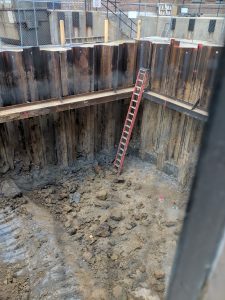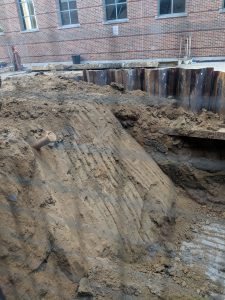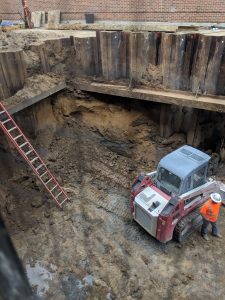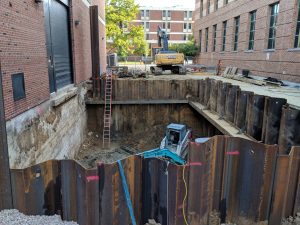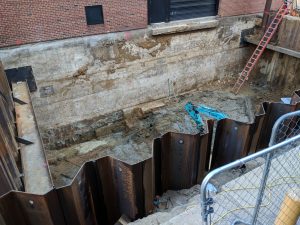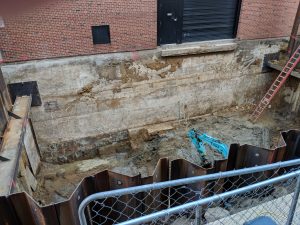Please see attached flyer for details
International Research Experiences for Student
An exciting student training opportunity in coastal management will take place in the Netherlands in
summer 2024 at Deltares, Utrecht University, and the Technical University of Delft – all established
European centers of excellence for advanced water management techniques. Selected students will participate in pre-travel virtual orientation and training programs, an on-site orientation in Delft (Netherlands), two weeks of hands-on classroom, modeling (Delft3D), laboratory, and field training, and enrichment activities in the Netherlands.
Program begins July 5, ends July 20, 2024,* and includes housing, meal, and travel costs for participants.
For additional details – see the attached PDF below.
CEE MS student RA opportunity
Seeking an MS-level student for a 1-year (renewable to 2-years) research project starting in Fall 2023. The study focuses on evapotranspiration (ET), the combination of evaporation from the surface and transpiration by plants during photosynthesis, in agricultural intensively managed landscapes. ET is a key link between the Earth’s water and energy balance, and varies depending on meteorological drivers and landscape characteristics such as soils, vegetation, and topography. The student will analyze high resolution satellite-based gridded ET products in midwestern watersheds along with other meteorological and landcover datasets, to quantify the impact of different aspects of landscape heterogeneity on ET fluxes. This project will involve analyzing large spatial and temporal datasets, developing a process-based understanding of ET as it can be observed or modeled, and working with a collaborative team from UIUC and PRI. This will be a 50% time, 11-month research assistant position.
Contact:
Dr. Allison Goodwell
Visiting Research Scientist, Prairie Research Institute (PRI)
Raising of CEE smart bridge
The CEE smart bridge was craned into place Saturday, October 17. Time lapse video is available here:
Time-lapse video of the Hydrosystems Lab renovation is available.
View the last 5 days of the renovation in the playlist below.
WRES well represented at the 2018 AGU fall meeting
Members of the WRES group are well represented at the AGU fall meeting scheduled for December 10-14, 2018 in Washington D.C. A list of posters and presentations follows below:
- OS12A-01 Autogenic subaqueous mechanism for continental shelf formation associated with clinoform migration: dissolved salt, gravity-driven and wave-supported turbidity currents Toshiki Iwasaki, Civil Engineering Research Institute for Cold Region, Hokkaido, Japan and Gary Parker, University of Illinois at Urbana Champaign, Urbana, IL, United States
- OS11A-01 Henry Pantin – a brilliant mind in autosuspension Jim Best1, Mike Leeder2, Jeffrey Peakall3, Gary Parker1, Robert Michael Dorrell4, Mark Franklin5 and William D McCaffrey6, (1)University of Illinois at Urbana Champaign, Urbana, IL, United States, (2)University of East Anglia, Norwich, United Kingdom, (3)University of Leeds, Leeds, LS2, United Kingdom, (4)University of Hull, HU6 7RX, UK, Energy and Environment Institute, Hull, United Kingdom, (5)Scottish Environment Protection Agency, Perth, United Kingdom, (6)University of Leeds, Leeds, United Kingdom
- H34H-02 Trade openness and the water and nutrient use of nations Megan Konar1, Qian Dang1 and Peter Debaere2, (1)University of Illinois at Urbana Champaign, Urbana, IL, United States, (2)University of Virginia Main Campus, Charlottesville, VA, United States
- H51F-02 Challenges and Opportunities of Multi-Scale Urban Energy and Water Data Christopher Chini, University of Illinois at Urbana Champaign, Urbana, IL, United States and Ashlynn S. Stillwell, University of Illinois at Urbana Champaign, Civil and Environmental Engineering, Urbana, IL, United States
- H21B-02 Looking Forward: What Can Information Flow Tell Us About Process and Model Dynamics? Praveen Kumar, Allison Eva Goodwell and Peishi Jiang, University of Illinois at Urbana Champaign, Urbana, IL, United States
- EP31A-04 QUANTIFYING THE EFFECTS OF OUTER-BANK LARGE WOOD ON FLOW-RESISTANCE AND BANK EROSION IN AN EVOLVING MEANDERING RIVER Dongchen Wang, University of Illinois at Urbana Champaign, Civil and Environmental Engineering, Urbana, IL, United States, Kory M Konsoer, Louisiana State University, Department of Geography and Anthropology, Baton Rouge, LA, United States, Marcelo H Garcia, University of Illinois at Urbana Champaign, Urbana, IL, United States, Bruce L Rhoads, Univ Illinois Urbana Champaign, Urbana, IL, United States, Eddy J Langendoen, USDA ARS, Pendleton, OR, United States and Jim Best, Univ. Illinois at Urbana Champaign, Geology, Geography & GIS, Mechanical Science and Engineering and Ven Te Chow Hydrosystems Laboratory, Champaign, IL, United States
- EP21A-04 The effect of alteration in flow duration curve on bankfull channel discharge and bankfull cross-sectional shape: model application to the Minnesota River, USA Kensuke Naito and Gary Parker, University of Illinois at Urbana Champaign, Urbana, IL, United States
- H11F-04 Food flows between counties in the United States Megan Konar1, Xiaowen Lin1, Paul Joseph Ruess2 and Landon Marston1, (1)University of Illinois at Urbana Champaign, Urbana, IL, United States, (2)University of Illinois at Urbana Champaign, Urbana, United States
- EP24A-04 Change in downstream bedform type, bed material sediment transport regime and flood potential in response to sediment blockage by a dam: can bed degradation increase flooding risk? Hongbo Ma1, Jeffrey A Nittrouer2, Yuanfeng Zhang3, Xudong Fu4, Yuanjian Wang3, Andrew J Moodie1, Yanjun Wang5, Baosheng Wu6 and Gary Parker7, (1)Rice University, Earth, Environmental and Planetary Sciences, Houston, TX, United States, (2)Rice University, Department of Earth, Environmental and Planetary Sciences, Houston, TX, United States, (3)Yellow River Institute of Hydraulic Research, Zhengzhou, China, (4)Tsinghua University, State Key Laboratory of Hydroscience and Engineering, Department of Hydraulic Engineering, Beijing, China, (5)Tsinghua University, Hydraulic Engineering, Beijing, China, (6)Tsinghua University, State Key Laboratory of Hydroscience and Engineering, Beijing, China, (7)University of Illinois at Urbana Champaign, Urbana, IL, United States
- OS11A-04 Turbidity currents in Xiaolangdi reservoir, Yellow River, China: dynamics and geomorphic expression Hongbo Ma1, Jeffrey A Nittrouer2, Brandon J McElroy3, Yuanjian Wang4, Andrew J Moodie1, Xingyu Chen5, Xudong Fu6, Baosheng Wu7 and Gary Parker8, (1)Rice University, Earth, Environmental and Planetary Sciences, Houston, TX, United States, (2)Rice University, Department of Earth, Environmental and Planetary Sciences, Houston, TX, United States, (3)University of Wyoming, Geology and Geophysics, Laramie, WY, United States, (4)Yellow River Institute of Hydraulic Research, Zhengzhou, China, (5)Tsinghua University, Beijing, China, (6)Tsinghua University, State Key Laboratory of Hydroscience and Engineering, Department of Hydraulic Engineering, Beijing, China, (7)Tsinghua University, State Key Laboratory of Hydroscience and Engineering, Beijing, China, (8)University of Illinois at Urbana Champaign, Urbana, IL, United States
- H13F-04 Co-evolutionary Perspective of Water Management in a Changing World Murugesu Sivapalan, University of Illinois, Urbana-Champaign, Urbana-Champaign, IL, United States
- H53D-05 Investigating short and long-term effects of Natural and Human-Induced Shocks on a Water Resources System in Sicily (Italy) through Socio-Hydrological Modeling Iolanda Borzì1,2, Alberto Viglione3, Murugesu Sivapalan4, Brunella Bonaccorso2 and Marlies Barendrecht5, (1)Vienna University of Technology, Vienna, Austria, (2)University of Messina, Department of Engineering, Messina, Italy, (3)Institute of Hydraulic Engineering and Water Resources Management, Vienna University of Technology, Vienna, Austria, (4)University of Illinois, Urbana-Champaign, Urbana-Champaign, IL, United States, (5)Vienna University of Technology, Institute of Hydraulic Engineering and Water Resources Managament, Vienna, Austria
- H42H-05 It’s raining bits: Trends in the information content of daily rainfall persistence across the U.S. Allison Eva Goodwell, University of Colorado Denver, Civil Engineering, Denver, CO, United States and Praveen Kumar, University of Illinois at Urbana Champaign, Urbana, IL, United States
- H13D-05 Modeling the Transport and Fate of Oil-Particle-Aggregates (OPAs) in Rivers after an Oil Spill David T Soong, USGS, Illinois-Iowa Water Science Center, Urbana, IL, United States, Zhenduo Zhu, University at Buffalo, Buffalo, NY, United States, Faith Fitzpatrick, U.S. Geological Survey, Madison, WI, United States and Tatiana Garcia, University of Illinois, Urbana, IL, United States
- GC51C-05 Quantifying the Effect of Farmer Management Decisions on Maize Yield in Zambia Michael Cecil1, Katherine Baylis2, Jordan Blekking3, Kelly K Caylor4, Tom P Evans5, Megan Konar6, Justin Sheffield7, Noemi Vergopolan7, Kurt Waldman3, Yi Zhao8 and Lyndon D Estes7, (1)Clark University, Worcester, MA, United States, (2)University of Illinois at Urbana Champaign, Agriculture and Consumer Economics, Urbana, IL, United States, (3)Indiana University Bloomington, Bloomington, IN, United States, (4)Princeton Univ-E-Quad, Princeton, NJ, United States, (5)University of Arizona, Tucson, AZ, United States, (6)University of Illinois at Urbana Champaign, Urbana, IL, United States, (7)Princeton University, Civil and Environmental Engineering, Princeton, NJ, United States, (8)Stanford University, Stanford, CA, United States
- H42C-06 Evaluation of the stationarity assumption for decadal drought risk estimation in continental US Tushar Apurv, University of Illinois at Urbana Champaign, Urbana, IL, United States and Ximing Cai, University of Illinois at Urbana Champaign, Department of Civil and Environmental Engineering, Urbana, IL, United States
- EP31A-06 Preferential Erosion Zones in Mixed Bedrock-Alluvial Meandering Rivers Roberto Fernandez1,2, Kensuke Naito1, Matthew John Czapiga3 and Gary Parker1, (1)University of Illinois at Urbana Champaign, Urbana, IL, United States, (2)University of Hull, Hull, United Kingdom, (3)University of Illinois at Urbana Champaign, Civil & Environmental Engineering, Urbana, IL, United States
- H12G-06 Utilizing Data Fusion to Understand and Visualize the U.S. Food, Energy, Water Nexus at the Mesocale: the FEWSION 1.0 Data Product Richard Rushforth, Northern Arizona University, Flagstaff, AZ, United States, Benjamin L Ruddell, Northern Arizona University, School of Informatics, Computing, and Cyber Systems, Flagstaff, United States, Megan Konar, University of Illinois at Urbana Champaign, Urbana, IL, United States, Kevin R Gurney, Arizona State University, Tempe, AZ, United States, Alfonso Mejia, Pennsylvania State University Main Campus, University Park, PA, United States, Okan Pala, North Carolina State University, Raleigh, United States and Tara Troy, Lehigh University, Civil and Environmental Engineering, Bethlehem, PA, United States
- IN53C-0633 Developing and Adapting Data Management Services Across Multiple Virtual Observatories Rob Kooper1, Luigi Marini2, Jong Lee2, Indira Gutierrez-Polo3, Max Burnette1, Michelle M Pitcel3, Marcus Slavenas4, Yan Zhao4, Paris Collingsworth5, David LeBauer6, Kenton McHenry7 and Praveen Kumar2, (1)University of Illinois at Urbana Champaign, NCSA, Urbana, IL, United States, (2)University of Illinois at Urbana Champaign, Urbana, IL, United States, (3)University of Illinois at Urbana Champaign, Urbana, United States, (4)University of Illinois at Urbana Champaign, National Center for Supercomputing Applications, Urbana, IL, United States, (5)Environmental Protection Agency Chicago, Chicago, IL, United States, (6)Energy Biosciences Institute, Urbana, IL, United States, (7)National Center for Super Computing Applications, Urbana, IL, United States
- H44F-07 Pore Network Stitching for Pore-to-Core Upscaling of Two-Phase Flow in Heterogeneous Rocks Amir Hossein Kohanpur, University of Illinois at Urbana Champaign, Dept of Civil and Environmental Engineering, Urbana, IL, United States and Albert J Valocchi, University of Illinois at Urbana-Champaign, Urbana, IL, United States
- OS12A-07 Thickness of quasi-equilibrium basal driving layer of turbidity current Norihiro Izumi1, Gary Parker2 and Rossella Luchi2, (1)Hokkaido University, Sapporo, Japan, (2)University of Illinois at Urbana Champaign, Urbana, IL, United States
- OS12A-08 The Magnificent Henry Pantin Discovered the Magnificent Formula for Excavating Magnificent Submarine Canyons: Autosuspension and Self-Acceleration Gary Parker, University of Illinois at Urbana Champaign, Urbana, IL, United States
- H11A-08 Comparing the Impact of Hydraulic Redistribution on Co-existing Vegetation Interaction in Semi-arid Upland and Riparian Sites Esther Lee1, Praveen Kumar1, Greg Barron-Gafford2 and Russell L Scott3, (1)University of Illinois at Urbana Champaign, Urbana, IL, United States, (2)University of Arizona, School of Geography and Development, Tucson, AZ, United States, (3)USDA-ARS, Southwest Watershed Research Center, Tucson, AZ, United States
- H22I-08 Understanding the Resilience of Soil Moisture Regimes Maoyuan Feng1, Pan Liu2, Ximing Cai3, Yu Li4 and Liangsheng Shi1, (1)Wuhan University, Wuhan, China, (2)Wuhan University, School of Water Resources and Hydropower Engineering, Wuhan, China, (3)University of Illinois at Urbana Champaign, Department of Civil and Environmental Engineering, Urbana, IL, United States, (4)Dalian University of Technology, Dalian, China
- NS43C-0853 Identification of Tile Drain Networks using Thermal and RGB Data from Unmanned Aircraft Scott Tyler, University of Nevada Reno, Geological Sciences and Engineering, Reno, NV, United States, Chris B Kratt, University of Nevada, Areno, Reno, NV, United States, Dongkook K Woo, University of Illinois, Urbana, United States, Kerri B Johnson, University of Nevada, Areno, Reno, United States, Marja Haagsma, Oregon State University, Corvallis, OR, United States, Chris Sladek, University of Nevada Reno, Reno, NV, United States, Praveen Kumar, University of Illinois at Urbana Champaign, Urbana, IL, United States and John S Selker, Oregon State University, Biological and Ecological Engineering, Corvallis, OR, United States
- NG41B-0942 Discerning the Thermodynamic Basis of Emergent Vegetation and Ecosystem Evolution Meredith Richardson and Praveen Kumar, University of Illinois at Urbana Champaign, Urbana, IL, United States
- GC53G-1035 A Network Analysis of Household Food Sharing in Zambia Rachel Marie von Gnechten1, Megan Konar1, Nicole D Jackson1, Katherine Baylis2, Patrese Anderson3, Stacey Giroux4 and Tom P Evans5, (1)University of Illinois at Urbana Champaign, Urbana, IL, United States, (2)University of Illinois at Urbana Champaign, Agriculture and Consumer Economics, Urbana, IL, United States, (3)University of Illinois at Urbana Champaign, Urbana, United States, (4)Indiana University Bloomington, Bloomington, United States, (5)University of Arizona, Tucson, AZ, United States
- ED33E-1124 Beyond the Water Cooler: Networking Lessons Learned by the Hydrology Section Student Subcommittee (H3S) Caitlyn A Hall1, Harsh Beria2, Megan R.M. Brown3, Frederick Y Cheng4, Kaylyn S Gootman5, Anna Hermes6, Sina Khatami7, Antonio Preziosi-Ribero8, Vinit Sehgal9, Meredith Richardson10 and Qina Yan10, (1)Arizona State University, Tempe, AZ, United States, (2)Institute of Earth Surface Dynamics, Faculty of Geosciences and Environment, University of Lausanne, Lausanne, Switzerland, (3)University of Colorado Boulder, Department of Geological Sciences, Boulder, CO, United States, (4)University of Waterloo, Department of Civil and Environmental Engineering, Waterloo, ON, Canada, (5)University of North Carolina at Chapel Hill, Curriculum in Environment and Ecology, Chapel Hill, NC, United States, (6)University of Colorado Boulder, Environmental Studies Program, Boulder, CO, United States, (7)University of Melbourne, Parkville, VIC, Australia, (8)Northwestern University, Evanston, IL, United States, (9)Texas A&M University, College Station, TX, United States, (10)University of Illinois at Urbana Champaign, Urbana, IL, United States
- H11J-1599 Quantifying the effects of climate variability and land use/cover change on sediment discharge in the Loess Plateau of China Guangyao Gao1, Jianjun Zhang1, Bojie Fu1 and Murugesu Sivapalan2, (1)Research Center for Eco-Environmental Sciences, Chinese Academy of Sciences, Beijing, China, (2)University of Illinois, Urbana-Champaign, Urbana-Champaign, IL, United States
- H11M-1628 Unraveling the Causal Dynamics in Stream Solutes by Using an Information-Theoretic Approach Peishi Jiang and Praveen Kumar, University of Illinois at Urbana Champaign, Urbana, IL, United States
- H13H-1819 Impact of Heterogeneity of Land-Cover on Land-Atmosphere Fluxes at an Intensively Managed Landscape Leila Constanza Hernandez Rodriguez and Praveen Kumar, University of Illinois at Urbana Champaign, Urbana, IL, United States
- H13H-1823 Thermodynamic potentials driving the hydrologic cycle: an integrated approach to system reliability in land-atmosphere interactions Sun Young Park and Arthur Schmidt, University of Illinois at Urbana Champaign, Civil and Environmental Engineering, Urbana, IL, United States
- H13M-1926 A decentralized optimization model to improve reliability of thermoelectricity supply during low flow and drought events Mengfei Mu, IGSNRR Institute of Geographic Sciences and Natural Resources Research, CAS, Beijing, China, Zhenxing Zhang, University of Illinois at Urbana Champaign, Urbana, IL, United States, Ximing Cai, University of Illinois at Urbana Champaign, Department of Civil and Environmental Engineering, Urbana, IL, United States and Qiuhong Tang, Institute of Geographic Sciences and Natural Resources Research, CAS, Beijing, China
- H21Q-1933 Scenario Analysis of Downstream Flow Impacts from Reclaimed Water Consumption in Two Distinct Regions Brendan Purcell, University of Colorado at Boulder, Civil, Environmental and Architecural Engineering, Boulder, CO, United States, Zachary A. Barker, Xylem Inc., Durham, NC, United States, Joseph R Kasprzyk, University of Colorado at Boulder, Boulder, CO, United States and Ashlynn S. Stillwell, University of Illinois at Urbana Champaign, Civil and Environmental Engineering, Urbana, IL, United States
- H21Q-1951 Grain and Virtual Water Stocks of the United States Paul Joseph Ruess, University of Illinois at Urbana Champaign, Urbana, United States and Megan Konar, University of Illinois at Urbana Champaign, Urbana, IL, United States
- H23Q-2196 An analytical framework for reservoir operation with combined natural inflow and controlled inflow Yu Li1,2, Xiaoxian Chen1, Wei Ding3, Chi Zhang4 and Ximing Cai5, (1)Dalian University of Technology, Dalian, China, (2)University of Illinois at Urbana Champaign, Civil and Environmental Engineering, Urbana, IL, United States, (3)Dalian University of Technology, School of Hydraulic Engineering, Dalian, China, (4)DUT Dalian University of Technology, Dalian, China, (5)University of Illinois at Urbana Champaign, Department of Civil and Environmental Engineering, Urbana, IL, United States
- H33K-2233 Litter Layer Controls on Ecosystem Hydrologic and Thermal Partitioning Kunxuan Wang and Praveen Kumar, University of Illinois at Urbana Champaign, Urbana, IL, United States
- EP21B-2235 Ultra-sensitivity of numerical landscape evolution models to their initial conditions Jeffrey S Kwang and Gary Parker, University of Illinois at Urbana Champaign, Urbana, IL, United States
- EP21D-2282 Upstream Migration of Sudden High-Slope to Low-Slope Knickpoint in a Mixed Bedrock-Alluvial Stream: Hydraulic Jump, Alluvial Scour and Plunge Pool Li Zhang1,2, Tiejian Li1,2, Toshiki Iwasaki3, Xiang Li4, Jiaye Li5, Guangqian Wang1,2 and Gary Parker6, (1)Tsinghua University, State Key Laboratory of Hydroscience and Engineering, Beijing, China, (2)Qinghai University, Water Resource and Electric Power Department, Xining, China, (3)Civil Engineering Research Institute for Cold Region, Hokkaido, Japan, (4)China Institute of Water Resources and Hydropower Research, Beijing, China, (5)Tsinghua University, Department of Hydraulic Engineering, Beijing, China, (6)University of Illinois at Urbana Champaign, Urbana, IL, United States
- H41N-2304 Interpretation of the division between surface flow and groundwater recharge at the monthly scale based on the generalized proportionality hypothesis Shuyue Wu, Tsinghua University, Beijing, China, Jianshi Zhao, Tsinghua University, Department of Hydraulic Engineering, Beijing, China, Murugesu Sivapalan, University of Illinois, Urbana-Champaign, Urbana-Champaign, IL, United States and Hao Wang, China Institute of Water Resources and Hydropower Research, Department of Water Resources, Beijing, China
- EP23C-2314 Laboratory Experiments on Flow Structure over Transient Ripples Geometry Chuang Jin1, Giovanni Coco1, Jorge Emilio San Juan Blanco2, Rafael O Tinoco2 and Evan B Goldstein3, (1)University of Auckland, Auckland, New Zealand, (2)University of Illinois at Urbana Champaign, Civil and Environmental Engineering, Urbana, IL, United States, (3)University of North Carolina at Chapel Hill, Geological Sciences, Chapel Hill, NC, United States
- H43C-2399 Modelling In-Stream Phosphorus Processes to Generate Insights on Point-Source Phosphorus Removal Kevin Wallington, University of Illinois at Urbana Champaign, Urbana, IL, United States, Ximing Cai, University of Illinois at Urbana Champaign, Department of Civil and Environmental Engineering, Urbana, IL, United States and Gregory McIsaac, University of Illinois, Urbana, United States
- H43E-2431 A New Theoretical Framework for Modeling Flow Duration Curves Saba Ghotbi1, Dingbao Wang1, Arvind Singh1, Guenter Bloeschl2 and Murugesu Sivapalan3, (1)University of Central Florida, Orlando, FL, United States, (2)Vienna University of Technology, Institute of Hydraulic Engineering and Water Resources Management, Vienna, Austria, (3)University of Illinois, Urbana-Champaign, Urbana-Champaign, IL, United States
- EP33D-2439 An Improved Analytical Method to Generate Synthetic Bed Topography of Single-thread Constant-width Meandering Rivers Zhi Li and Marcelo H Garcia, University of Illinois at Urbana Champaign, Urbana, IL, United States
- B23I-2640 Improved Grazing Management Increases Soil Carbon Sequestration in Subtropical Pastures Nuria Gomez-Casanovas1, Elena Blanc-Betes2, Elizabeth Boughton3, Carl Bernacchi4 and Evan H DeLucia1, (1)University of Illinois at Urbana Champaign, Institute for Sustainability, Energy, and Environment, Urbana, IL, United States, (2)University of Illinois at Urbana-Champaign, Institute for Sustainability, Energy, and Environment, Urbana, IL, United States, (3)MacArthur Agro-ecology Research Center, Archbold Biological Station, Lake Placid, FL, United States, (4)University of Illinois at Urbana-Champaign, Department of Plant Biology, Urbana, IL, United States
- EP41B-2674 Super diffusion of bedload tracer transport at intermediate time scales explained via a new analytical formulation Zi Wu1,2, Efi Foufoula-Georgiou1, Gary Parker3, Arvind Singh4, Xudong Fu5 and Guangqian Wang6, (1)University of California Irvine, Department of Civil and Environmental Engineering, Irvine, CA, United States, (2)University of Central Florida, Department of Civil, Environmental & Construction, Orlando, FL, United States, (3)University of Illinois at Urbana Champaign, Urbana, IL, United States, (4)University of Central Florida, Civil, Environmental, And Construction Engineering, Orlando, FL, United States, (5)Tsinghua University, State Key Laboratory of Hydroscience and Engineering, Department of Hydraulic Engineering, Beijing, China, (6)Tsinghua University, State Key Laboratory of Hydroscience and Engineering, Beijing, China
- B23K-2680 Coupled Modeling of Active Root Zone and Nutrient Cycling Processes Susana Roque-Malo and Praveen Kumar, University of Illinois at Urbana Champaign, Urbana, IL, United States
- EP41D-2703 Effect of Emergent Vegetation on Suspended Sediment Transport Pallav Ranjan1, Som Dutta2, Paul Fischer3 and Rafael O Tinoco1, (1)University of Illinois at Urbana Champaign, Civil and Environmental Engineering, Urbana, IL, United States, (2)City University of New York, Department of Mathematics, New York, NY, United States, (3)University of Illinois at Urbana Champaign, Computer Science and MechSE, Urbana, IL, United States
- EP43C-2718 Experimental study of the temporal and spatial distribution of turbulence within vegetation under oscillatory flows Jorge Emilio San Juan Blanco and Rafael O Tinoco, University of Illinois at Urbana Champaign, Civil and Environmental Engineering, Urbana, IL, United States
- EP43C-2726 Grass Carp Response to Flow Turbulence: Egg Mortality and Larvae Response to Altered Flows. Rafael O Tinoco1, Andres F Prada2, Amy George3, Benjamin Stahlschmidt3 and Duane C Chapman3, (1)University of Illinois at Urbana Champaign, Civil and Environmental Engineering, Urbana, IL, United States, (2)University of Illinois at Urbana Champaign, Urbana, IL, United States, (3)USGS Columbia Environmental Research Center, Columbia, MO, United States
- EP51B-28 3-D Modeling of the Co-evolution of Landscape and Soil Organic Carbon Qina Yan1, Praveen Kumar1, Phong Le2, Timothy R Filley3, Dong Kook Woo4 and Tingyu Hou3, (1)University of Illinois at Urbana Champaign, Urbana, IL, United States, (2)University of Illinois at Urbana-Champaign, Civil and Environmental Engineering, Urbana, IL, United States, (3)Purdue University, Earth, Atmospheric, and Planetary Sciences, West Lafayette, IN, United States, (4)University of Illinois, Urbana, IL, United States
- EP53B-30 Direct Numerical Simulation of oscillatory boundary layers in the intermittent-turbulent/transitional regime: coherent structures and turbulent statistics Dimitrios K. Fytanidis1, Jose M Mier2, Marcelo H Garcia1 and Paul Fischer3, (1)University of Illinois at Urbana Champaign, Urbana, IL, United States, (2)University of Illinois at Urbana-Champaign, Urbana, IL, United States, (3)University of Illinois at Urbana Champaign, Computer Science and MechSE, Urbana, IL, United States
- TH23A: Alternative Careers: Research in Action in Washington, D. C. Meredith Richardson, University of Illinois at Urbana-Champaign; Debra Knopman, RAND Corporation; Alexis McKittrick, Claudia Ringler, Helen Ding, World Resources Institute
Construction on new laboratory sump begins
As part of the renovation of the Hydrosystems Laboratory, a new 50,000 gallon sump is being built on the west side of the building between the Hydrosystems Laboratory and the Coordinated Sciences Laboratory to support continued activities within the main laboratory space, the Ven Te Chow Laboratory. The new sump will replace the existing 100,000 gallon sump that is within the footprint of the building renovation that will be removed to make room for basement laboratories and research space. The reduced volume of the sump is made possible by optimizing the geometry to minimize the “dead” volume required to ensure that the pumps had a sufficient water depth to prevent air entrainment. This is aided by a change in pump style from vertical column pumps to bottom-suction submersible pumps. Once completed near the start of 2019, the system is expected to supply up to 12 cfs of flow to the existing laboratory piping system – matching or exceeding the existing capacity. A few photos of the sump excavation are below.
Name Change
The Environmental Hydrology and Hydraulic Engineering (EHHE) program in the Department of Civil and Environmental Engineering is changing its name to Water Resources Engineering and Science (WRES) to better reflect areas of study within the program outside of traditional hydrology and hydraulic engineering. These areas include water policy and water-resources management, as well as hydrology and hydraulic engineering. The name change will be effective Summer 2018.
